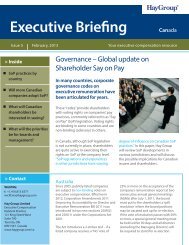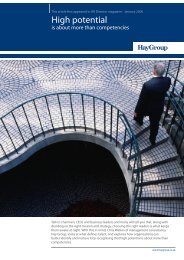East meets west - Hay Group
East meets west - Hay Group
East meets west - Hay Group
Create successful ePaper yourself
Turn your PDF publications into a flip-book with our unique Google optimized e-Paper software.
5<br />
Three challenges facing Chinese CEOs<br />
Many Chinese businesses seek to<br />
expand and to become international<br />
or global. However, they face three<br />
particular challenges. While these three<br />
areas highlight room for improvement<br />
within the Chinese domestic market,<br />
they become even more important in<br />
the light of the international ambitions<br />
of many Chinese businesses.<br />
Talent management<br />
China, like many other parts of the<br />
world, is facing a significant shortage in<br />
talent. The situation is particularly acute<br />
as firms are undergoing rapid expansion<br />
and with scarcity driving up wages, high<br />
turnover is a key issue.<br />
Some 23 out of the 30 CEOs surveyed<br />
identified talent management as one of<br />
their own three biggest challenges.<br />
However, while talent management<br />
was identified as a critical issue, only<br />
six leaders actually told stories about<br />
developing or managing talent. Of these,<br />
only three indicated real success. Perhaps<br />
one reason for the lack of attention to<br />
talent is that rather than addressing talent<br />
management issues, Chinese CEOs are<br />
devoting a significant amount of time to<br />
raising capital – a responsibility normally<br />
associated in the West with the role of<br />
the chief financial officer.<br />
Clearly, in the future, the ability to<br />
fill the talent gap will be critical to the<br />
success of Chinese CEOs, as much as<br />
CEOs elsewhere. They must develop<br />
their ability to build organisational<br />
capability in order to be successful.<br />
This requires a commitment on the part<br />
of leaders to taking practical action to<br />
improve the long term talent capability<br />
of their organisation.<br />
In practice this involves ensuring that<br />
the right people are in key strategic roles.<br />
It is also demonstrated by establishing<br />
the operating systems and processes and<br />
organisational structures necessary to<br />
respond to current skills shortages in<br />
capability as well as to develop capability<br />
in the long term.<br />
Leaders possessing this competence<br />
in good measure will be concerned to<br />
foster the long-term development of<br />
others, and will seek to leave a legacy<br />
by developing good leaders who will be<br />
ready to take over.<br />
Organisational climate<br />
The question of the organisational<br />
climate created by the leader is a<br />
significant one as the success of an<br />
organisation depends on fully engaging<br />
the efforts and commitment of the top<br />
team and larger employee population,<br />
not just the CEO.<br />
While the tendency towards self<br />
criticism has already been noted as a<br />
distinctively Chinese management trait<br />
and one that will be new to many in<br />
the West, our interviews also identified<br />
other leadership styles which could<br />
initially be confusing to Westerners.<br />
The Chinese leadership style is<br />
predominantly paternalistic in nature.<br />
Chinese CEOs are less likely to give

















